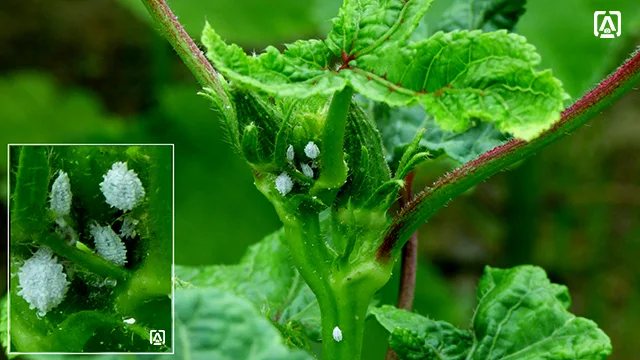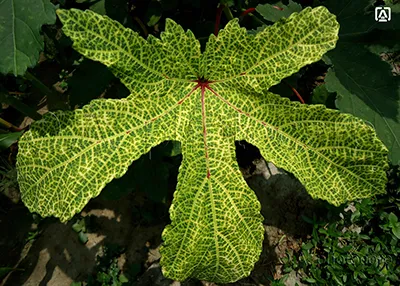Mealybugs on okra
About the disease
Okra are very prone to the attack of mealybugs. Mealybugs belong to the family Pseudococcidae of Hemiptera. Mealybugs are small insects, covered with the waxy material. Mealybugs attack axil of leaves, young leaves and developing fruits, where they draw nutrients from the plant by piercing mouth part into the phloem, thus, making the plants deprived of nutrition. Mealybugs secrete honeydew, which attract ants and favor the growth of sooty molds. Plant become stunted, growth of the fruits and young leaves retarded and shoot apex become curled. Mealybugs have a wide host range, where they attack many vegetables, fruits and cotton.
 |
| Shoot apex of okra infested with mealybugs (enlarged in inset box) |
Control measures
- Small population can be controlled by water jet.
- Previously infested crops should be removed and burnt.
- Biological control through the other small insects, e.g., Garden ladybugs, Australian ladybirds Anagyrus pseudococci, Leptomastix dactylopii, Hypoaspis sp. can be achieved. These insects eat mealybugs.
- Fungi, like Verticillium lecanii and Beauveria bassiana are effectively control the mealybug population.
- Spray of porfenophos 40 % + cypermethrin 4 % EC gives good results .(personal observation).
Yellow vein mosaic of Bhindi
Host: Abelmoschus esculentus L. (Bhindi, Bhendi, Okra)
Pathogen: Bhendi Yellow Vein Mosaic Virus (BYVMV)
Transmission of virus (Vector): White fly (Bemisia tabaci)
Pathogen: Bhendi Yellow Vein Mosaic Virus (BYVMV)
Transmission of virus (Vector): White fly (Bemisia tabaci)
Distribution
Yellow vein mosaic is a very common disease of bhindi (okra). This disease was first reported in 1924 by Kulkarni from Bombay, India. The disease is cosmopolitan in distribution and reported from the everywhere, the crop is grown. The disease is extensively reported from the India, Pakistan and Sri Lanka.
Symptoms
 |
| Leaf of Okra showing typical symptoms of yellow vein mosaic |
The veins of infected plants start losing green color of chlorophyll (vein clearing). Within a few days of infection, all the veins become yellow leaving the rest area green. In severe cases, the chlorotic veins become thicker at the lower side.
The infected plants show reduced leaves and stunted growth. Dramatic decrease in yield is observed. The fruit formed are deformed, short and fibrous.
The infected plants show reduced leaves and stunted growth. Dramatic decrease in yield is observed. The fruit formed are deformed, short and fibrous.
Pathogen
Yellow vein mosaic of bhindi (okra) is caused by Bhendi Yellow Vein Mosaic Virus (BYVMV). BYVMV is a monopartite begomovirus, which belongs to the family geminiviridae. Geminiviruses are plant virus usually comprising two similar-sized DNA components (DNA A and DNA B) responsible for encoding various proteins. The genetic material of geminiviruses is small circular ssDNA. The BYVMV is however, a monopartite virus consisting of DNA very similar to DNA A component of bipartite geminivirus.
Recently a small satellite DNA β component has been identified in association with the BYVMV. This satellite DNA β component is thought to be responsible for the typical yellow vein mosaic of bhindi.
Recently a small satellite DNA β component has been identified in association with the BYVMV. This satellite DNA β component is thought to be responsible for the typical yellow vein mosaic of bhindi.
Transmission
BYVMV are transmitted by whitefly (Bemisia tabaci) belonging to the Aleyrodidae of Hemiptera. According to Venkataravanappa et al. (2017), female whiteflies are more efficient in transmitting the BYVMV as compared to male ones.
Control measures
- As the disease is viral, preventive measures are the effective methods of controlling the disease.
- On appearance of the symptoms, diseased plant should immediately be burnt.
- Eradication of alternate host weeds, such as Croton, Hibiscus tetraphyllus, Ageratum should be practiced.
- Resistant varieties such as, M 64 (Mahyco), Sonal (Nunhems), Syn 152 (Syngenta), Avantika (Bioseeds), Hyb 801 (Namdhari Seeds) should be grown.
Sources
- Venkataravanappa, V., Kodandaram, M.H., Reddy, C.L., Shankarappa, K.S. and Reddy, M.K., 2017. Comparative transmission of Bhendi yellow vein mosaic virus by two cryptic species of the whitefly, Bemisia tabaci (Hemiptera: Aleyrodidae). 3 Biotech, 7(5), p.331.(https://dx.doi.org/10.1007%2Fs13205-017-0970-8).
- Jose, J. and Usha, R., 2003. Bhendi yellow vein mosaic disease in India is caused by association of a DNA β satellite with a begomovirus. Virology, 305(2), pp.310-317. (https://doi.org/10.1006/viro.2002.1768).





0 Comments
Leave your comments here.